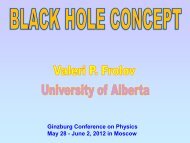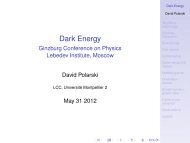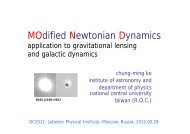Chern-Simons vector models and higher spins - Ginzburg ...
Chern-Simons vector models and higher spins - Ginzburg ...
Chern-Simons vector models and higher spins - Ginzburg ...
- No tags were found...
You also want an ePaper? Increase the reach of your titles
YUMPU automatically turns print PDFs into web optimized ePapers that Google loves.
<strong>Chern</strong>-<strong>Simons</strong> <strong>vector</strong> <strong>models</strong> <strong>and</strong> <strong>higher</strong> <strong>spins</strong>Simone GiombiPerimeter Institute<strong>Ginzburg</strong> Conference, Moscow, June 1 2012Simone Giombi (PI) <strong>Chern</strong>-<strong>Simons</strong> <strong>and</strong> <strong>higher</strong> <strong>spins</strong> Lebedev Inst., Jun 1 2012 1 / 24
OutlineThe Klebanov-Polyakov-Sezgin-Sundell conjectures:HS gravity in AdS 4 ↔ 3d <strong>vector</strong> <strong>models</strong>Vasiliev’s <strong>higher</strong> spin gauge theory in 4dthe “Type A” <strong>and</strong> “Type B” <strong>models</strong>Parity violating <strong>models</strong><strong>Chern</strong>-<strong>Simons</strong> theory with <strong>vector</strong> fermion matterExact planar thermal free energy on R 2Higher spin symmetry at large N <strong>and</strong> conjectural AdS dualSummary <strong>and</strong> conclusionsBased on work with S. Minwalla, S. Prakash, S. Trivedi, S. Wadia, X. YinSimone Giombi (PI) <strong>Chern</strong>-<strong>Simons</strong> <strong>and</strong> <strong>higher</strong> <strong>spins</strong> Lebedev Inst., Jun 1 2012 2 / 24
Klebanov-Polyakov-Sezgin-Sundell (’02) conjecture:Vasiliev’s minimal bosonic HS gravity in AdS 4 is dual tofree or critical 3d O(N) <strong>vector</strong> model, in the O(N) singlet sector.S = 1 2∫d 3 x∂ µ φ i ∂ µ φ i ↔ “type A” HS gravity∫S =(∆, S) = (1, 0) + + ∑ s even(s + 1, s)d 3 xψ i γ µ ∂ µ ψ i ↔ “type B” HS gravity(∆, S) = (2, 0) − + ∑ s even(s + 1, s)Critical theories: interacting fixed points reached after perturbing these freetheories by quartic interaction. Correspond to change of boundary conditionon the bulk scalar field in the HS gravity side.Non-minimal versions (all integer <strong>spins</strong>): <strong>vector</strong> <strong>models</strong> with complex fieldsin U(N) singlet sector.Simone Giombi (PI) <strong>Chern</strong>-<strong>Simons</strong> <strong>and</strong> <strong>higher</strong> <strong>spins</strong> Lebedev Inst., Jun 1 2012 3 / 24
Klebanov-Polyakov-Sezgin-Sundell (’02) conjecture:Vasiliev’s minimal bosonic HS gravity in AdS 4 is dual tofree or critical 3d O(N) <strong>vector</strong> model, in the O(N) singlet sector.Why <strong>vector</strong> <strong>models</strong>? A free gauge theory of SYM type also has HScunserved currents J s ∼ TrΦ∂ s Φ. But in addition there are manymore single trace operators Tr Φ∂ k 1Φ∂ k 2Φ · · · ∂ kn Φ, which should bedual to massive fields in the bulk.In a <strong>vector</strong> theory, operators of the form (φ i ∂ · · · ∂φ i )(φ j ∂ · · · ∂φ j ) areanalogous to multi-trace operators <strong>and</strong> should be thought asmulti-particle states from bulk point of view.A <strong>vector</strong> model has precisely the right spectrum to be dual to a pureHS gauge theory!Simone Giombi (PI) <strong>Chern</strong>-<strong>Simons</strong> <strong>and</strong> <strong>higher</strong> <strong>spins</strong> Lebedev Inst., Jun 1 2012 4 / 24
Klebanov-Polyakov-Sezgin-Sundell (’02) conjecture:Vasiliev’s minimal bosonic HS gravity in AdS 4 is dual tofree/critical 3d O(N) <strong>vector</strong> model, in the O(N) singlet sector.The restriction to singlet sector is important to match boundary <strong>and</strong>bulk spectrum. It may be implemented by gauging the O(N)symmetry <strong>and</strong> taking a limit of zero gauge coupling. In practice, wemay couple the <strong>vector</strong> field to a <strong>Chern</strong>-<strong>Simons</strong> gauge field at level k,<strong>and</strong> take the limit k → ∞.This suggests it may be interesting to study more generally <strong>vector</strong><strong>models</strong> coupled to <strong>Chern</strong>-<strong>Simons</strong> at finite coupling (i.e. finiteλ = N/k in the large N limit).Simone Giombi (PI) <strong>Chern</strong>-<strong>Simons</strong> <strong>and</strong> <strong>higher</strong> <strong>spins</strong> Lebedev Inst., Jun 1 2012 5 / 24
The Vasiliev’s equationsMaster fields:1. W (x|y, ȳ, z, ¯z) = W µ dx µ 1-form in space-time2. S(x|y, ȳ, z, ¯z) = S α dz α + S ˙α d¯z ˙α 1-form in (z, ¯z)-space3. B(x|y, ȳ, z, ¯z) scalarx µ : spacetime, y α , ȳ ˙α , z α , ¯z ˙α : twistor variables.Collecting W <strong>and</strong> S into the 1-form A = W µ dx µ + S α dz α + S ˙α d¯z ˙α ,Vasiliev’s equation can be written asdA + A ∗ A = V(B ∗ κ)dz 2 + ¯V(B ∗ ¯κ)d¯z 2dB + A ∗ B − B ∗ π(A) = 0Simone Giombi (PI) <strong>Chern</strong>-<strong>Simons</strong> <strong>and</strong> <strong>higher</strong> <strong>spins</strong> Lebedev Inst., Jun 1 2012 6 / 24
The Vasiliev’s equationsdA + A ∗ A = V(B ∗ κ)dz 2 + ¯V(B ∗ ¯κ)d¯z 2dB + A ∗ B − B ∗ π(A) = 0Up to field redefinitions, V(X ) can be put in the formV(X ) = X exp ∗ (iΘ(X )) ,Θ(X ) = θ 0 + θ 2 X ∗ X + θ 4 X ∗ X ∗ X ∗ X + . . .An infinite family of HS gravity theories in 4d. Same spectrum, but achoice of Θ(X ) characterizes the interactions in the theory.(e.g. θ 0 affects 3-point interactions. θ 2 , θ 4 , . . . enter in <strong>higher</strong>-pointfunctions)Simone Giombi (PI) <strong>Chern</strong>-<strong>Simons</strong> <strong>and</strong> <strong>higher</strong> <strong>spins</strong> Lebedev Inst., Jun 1 2012 7 / 24
ParityIf we impose that the theory has a parity symmetry only twoinequivalent choices are left• Θ(X ) = 0, i.e. V(X ) = X if B is parity even• Θ(X ) = π , i.e. V(X ) = iX if B is parity odd2which correspond respectively to the “type A” <strong>and</strong> “type B” <strong>models</strong>,conjecturally dual to scalar/fermion <strong>vector</strong> <strong>models</strong> (free or critical).If we do not require parity symmetry, we have a large class of possibleparity breaking HS gravity theories parameterized by a choice of thefunction Θ(X ), or parameters θ 0 , θ 2 , . . ..At least classically, these are all consistent HS theories in AdS 4 . Onemay ask what are the dual CFTs.Simone Giombi (PI) <strong>Chern</strong>-<strong>Simons</strong> <strong>and</strong> <strong>higher</strong> <strong>spins</strong> Lebedev Inst., Jun 1 2012 8 / 24
<strong>Chern</strong>-<strong>Simons</strong> <strong>vector</strong> modelSG, S. Minwalla, S. Prakash, S. Trivedi, S. Wadia, X. Yin 2011Consider the 3d theory of a fundamental massless fermion coupled toa U(N) <strong>Chern</strong>-<strong>Simons</strong> gauge field at level kS = k ∫4π S CS(A) + d 3 x ¯ψ i γ µ D µ ψ i i = 1, . . . , NIn 3d, ψ has dimension 1, <strong>and</strong> the only marginal coupling is the<strong>Chern</strong>-<strong>Simons</strong> coupling k. This cannot run because it is quantized tobe integer.Fine-tuning the mass of the fermion to zero, we obtain a family ofinteracting CFT’s labelled by two integers k, N.Taking k → ∞, this reduces to the singlet sector of the free fermionic<strong>vector</strong> model dual to Vasiliev’s type B theory.Simone Giombi (PI) <strong>Chern</strong>-<strong>Simons</strong> <strong>and</strong> <strong>higher</strong> <strong>spins</strong> Lebedev Inst., Jun 1 2012 9 / 24
<strong>Chern</strong>-<strong>Simons</strong> <strong>vector</strong> modelS = k ∫4π S CS(A) + d 3 x ¯ψ i γ µ D µ ψ i i = 1, . . . , NWe will be interested in the large N ’t Hooft limitN → ∞, k → ∞ with λ = N k fixedIn this limit, we effectively have a continuous line of non-susy CFT’sparameterized by λ. At λ = 0 we reduce to the free fermionic <strong>vector</strong>model.All I said so far applies for fermion being in any representation, e.g.the adjoint. However, working with a <strong>vector</strong> fermion entails severalsimplifications so that exact results become possible.The analogous <strong>Chern</strong>-<strong>Simons</strong> bosonic <strong>vector</strong> model has been studiedin parallel to our work in Aharony et. al., 2011. Also, interesting workin progress on susy extensions of these <strong>Chern</strong>-<strong>Simons</strong> <strong>vector</strong> <strong>models</strong>(see X. Yin talk).Simone Giombi (PI) <strong>Chern</strong>-<strong>Simons</strong> <strong>and</strong> <strong>higher</strong> <strong>spins</strong> Lebedev Inst., Jun 1 2012 10 / 24
<strong>Chern</strong>-<strong>Simons</strong> <strong>vector</strong> modelI will discuss in particular two interesting results about the large Nlimit of this <strong>Chern</strong>-<strong>Simons</strong> <strong>vector</strong> model1. The exact free energy of the theory on R 2 at finite temperatureF = −T log Z R 2 ×S 1 β = − h(λ) NV 2T 3h(λ) is a non-trivial function which we can compute exactly in λ.2. At N → ∞, for all λ, the theory admits an ∞-dimensional <strong>higher</strong> <strong>spins</strong>ymmetry, i.e. there is an infinite tower of HS currentsJ s , s = 1, 2, 3, . . . which are conserved at large N, so that∆(J s ) = s + 1 + O( 1 N )∀ λSimone Giombi (PI) <strong>Chern</strong>-<strong>Simons</strong> <strong>and</strong> <strong>higher</strong> <strong>spins</strong> Lebedev Inst., Jun 1 2012 11 / 24
Exact thermal free energyThe <strong>Chern</strong>-<strong>Simons</strong> gauge field does not carry propagating degrees offreedom, so the theory is still essentially a <strong>vector</strong> model, <strong>and</strong> weexpect it to be simpler than a typical large N gauge theory.However, the cubic self-interaction of the CS gauge field still makesperturbation theory complicated in general.Drastic simplifications can be achieved in a convenient gauge. Weemploy the “light-cone gauge”A − = 0 x ± = x 1 ± ix 2Here x 1 , x 2 are the Euclidean coordinates on R 2 . The Euclidean timedirection is x 3 , which will be compactified on a circle of radiusβ = 1/T .In this gauge, the cubic self-interaction vanishes, <strong>and</strong> the large N freeenergy can be solved exactly.Simone Giombi (PI) <strong>Chern</strong>-<strong>Simons</strong> <strong>and</strong> <strong>higher</strong> <strong>spins</strong> Lebedev Inst., Jun 1 2012 12 / 24
Exact fermion propagatorThe basic ingredient we need to get the free energy is the exactfermion propagator〈ψ(p) i ¯ψ(−p) j〉 = δ j i1ip µ γ µ + Σ(p)Σ(p) is the exact fermion self-energy. In the light-cone gauge <strong>and</strong> inthe planar limit, it receives contributions only from 1PI rainbowdiagrams+ + . . .Note that diagrams with matter loops do not contribute at leadingorder at large N, because the fermion is in the fundamental.Simone Giombi (PI) <strong>Chern</strong>-<strong>Simons</strong> <strong>and</strong> <strong>higher</strong> <strong>spins</strong> Lebedev Inst., Jun 1 2012 13 / 24
Exact fermion propagatorIt is not difficult to see that the sum of rainbow diagramscontributing to Σ(p) satisfies the Schwinger-Dyson equationΣ(p) = N 2∫d 3 ()q(2π) 3 γ µ 1iγ α q α + Σ(q) γν G µν (p − q)Here G µν (p) is the light-cone A µ propagator: G +3 = −G 3+ = 4πikp. +At finite temperature, we impose antiperiodic b.c. on the fermion, soq 3 = 2π ∫ ∫(n + 1/2), d 3 q → d 2 q ∑βZ+1/2Simone Giombi (PI) <strong>Chern</strong>-<strong>Simons</strong> <strong>and</strong> <strong>higher</strong> <strong>spins</strong> Lebedev Inst., Jun 1 2012 14 / 24
Exact fermion propagatorEmploying the “dimensional reduction” scheme to regulate the loopintegrals (shown to be consistent in CS-matter theories by Chen,Semenoff, Wu ’92 up to 2-loops), we solved the Schwinger-Dysonequation explicitly.The solution takes the formwithΣ(p) = f (βp s)p s + i g(βp s)p − γ + p 2 s ≡ p 2 1 + p 2 2f (y) = 2λ ( [ 1y log √])2 cosh c2 + y2 2 , g(y) = c2y − f 2 (y)2(c = 2λ log 2 cosh c )2The equation determining c = c(λ) has no solutions for |λ| ≥ 1. Weconclude that the CFT is defined only for 0 ≤ |λ| < 1.Simone Giombi (PI) <strong>Chern</strong>-<strong>Simons</strong> <strong>and</strong> <strong>higher</strong> <strong>spins</strong> Lebedev Inst., Jun 1 2012 15 / 24
Exact thermal free energyOnce we have the exact fermion self-energy Σ, one may show by pathintegral or diagrammatically that the free energy is given in terms ofΣ byF = NV ∑ ∫ [ d 2 q2T(2π) Tr log [iγ µ q 2 µ + Σ(q)] − 1 ()]2 Σ(q) 1iγ µ q µ + Σ(q)nPerforming the integral <strong>and</strong> sum, the final result isF = − NV 2T 3 [c 3 1 − λ ∫ ∞+ 6 dy y log ( 1 + e −y )] ≡ −NV 2 T 3 h(λ)6π λwhere c = c(λ) is the constant introduced earlier.cSimone Giombi (PI) <strong>Chern</strong>-<strong>Simons</strong> <strong>and</strong> <strong>higher</strong> <strong>spins</strong> Lebedev Inst., Jun 1 2012 16 / 24
FNV 2 T 30.250.200.150.100.050.2 0.4 0.6 0.8 1.0 Λh(λ) = 3ζ(3) 2(log 2)3− λ 2 (log 2)4− λ 4 + . . . λ ≪ 14π 3π 2π(1 − λ)h(λ) ∼ log 3 (1 − λ) + . . . λ → 16πThe function h(λ) decreases monotonically from the free field valueto zero at λ = 1. Extreme thinning of d.o.f. at “strong coupling”.For comparison, in ABJM model we have h(λ) ∼ 1/ √ λ at λ → ∞.Simone Giombi (PI) <strong>Chern</strong>-<strong>Simons</strong> <strong>and</strong> <strong>higher</strong> <strong>spins</strong> Lebedev Inst., Jun 1 2012 17 / 24
Higher spin symmetry at large NRecall that in the free theory (λ = 0), the spectrum of U(N) invariantsingle trace primaries isJ 0 = ¯ψ i ψ i , J s ∼ ¯ψ i γ (µ1 ∂ µ2 · · · ∂ µs)ψ i + . . .In the interacting theory, these can be made gauge invariant by∂ µ → D µ . The CS sector does not add any further single-traceprimaries, because (F µν ) i j ∼ 1 k ¯ψ j γ ρ ψ i ɛ µνρ by e.o.m.In the free theory ∂ · J s = 0, i.e. J s are in short representations of theconformal algebra with (∆, S) = (s + 1, s).Turning on the interaction, we expect the currents not to beconserved any more <strong>and</strong> to acquire anomalous dimension∆ s = s + 1 + ɛ s (λ, N).Simone Giombi (PI) <strong>Chern</strong>-<strong>Simons</strong> <strong>and</strong> <strong>higher</strong> <strong>spins</strong> Lebedev Inst., Jun 1 2012 18 / 24
Higher spin symmetry at large NBut for the currents to become non-conserved at λ ≠ 0, we musthave∂ · J s ∼ λO (s+2,s−1)In other words, there must be an operator in the (s + 2, s − 1)representation with which J s can combine to form a longrepresentation.At N = ∞, single trace operators can only combine with other singletrace operators. But there are no single-trace primaries in thespectrum with quantum numbers (s + 2, s − 1)!Therefore we conclude that at N = ∞, for all λ, the currents are stillconserved, which implies∆(J s ) = s + 1 + O( 1 N )∀ λThe <strong>vector</strong> nature of ψ is essential for this to work.Simone Giombi (PI) <strong>Chern</strong>-<strong>Simons</strong> <strong>and</strong> <strong>higher</strong> <strong>spins</strong> Lebedev Inst., Jun 1 2012 19 / 24
Higher spin symmetry at large NWhat happens is that, at finite N, J s can (<strong>and</strong> does) combine with“multi-trace” operators. The non-conservation equation takes theschematic form∂ · J s ∼ f √ (λ) ∑∂ m J s1 ∂ n J s2 + g(λ) ∑∂ m J s1 ∂ n J s2 ∂ p J s3N NThe argument above implies that the HS currents do not haveanomalous dimensions in the planar limit. But one can in fact arguethat the scalar J 0 has protected dimension as well∆(J 0 ) = 2 + O( 1 N )which we have checked perturbatively to two-loop order.Simone Giombi (PI) <strong>Chern</strong>-<strong>Simons</strong> <strong>and</strong> <strong>higher</strong> <strong>spins</strong> Lebedev Inst., Jun 1 2012 20 / 24
Comments on the holographic dualAt λ = 0, we know that the theory should be dual to the Vasiliev’s“type B” theory. So the holographic dual should be some deformationof it.Turning on λ, we have seen that the spectrum of “single trace”primaries is(∆, S) = (2 + O( 1 ∞ N ), 0) + ∑(s + 1 + O( 1 ), s)Nwhich implies that the dual bulk spectrum should contain classicallymassless <strong>higher</strong> spin fields <strong>and</strong> a m 2 = −2 scalar.The HS fields (<strong>and</strong> the scalar) can acquire mass via loop-corrections,but the bulk classical equations of motion should have exact <strong>higher</strong>spin gauge symmetry (to decouple longitudinal polarizations).Hence, the holographic dual should still be a <strong>higher</strong> spin gauge theory(with HS symmetry broken at quantum level), <strong>and</strong> it should breakparity due to the boundary <strong>Chern</strong>-<strong>Simons</strong> term.Simone Giombi (PI) <strong>Chern</strong>-<strong>Simons</strong> <strong>and</strong> <strong>higher</strong> <strong>spins</strong> Lebedev Inst., Jun 1 2012 21 / 24s=1
Comments on the holographic dualThe only parity breaking <strong>higher</strong> spin gravity theory currently known isVasiliev’s theory specified by the general “interaction phase”Θ(X ) = θ 0 + θ 2 X ∗ X + . . .A natural conjecture is then that our <strong>Chern</strong>-<strong>Simons</strong> <strong>vector</strong> model isdual to the parity breaking Vasiliev’s theory with some specific choiceθ 0 (λ) , θ 2 (λ) , . . .with the condition that θ 0 (λ → 0) = π 2 , θ 2,4,...(λ → 0) = 0.We do not know a priori how to determine the phase as a function ofλ. But we can in principle compute perturbatively correlators on bothsides <strong>and</strong> compare.Simone Giombi (PI) <strong>Chern</strong>-<strong>Simons</strong> <strong>and</strong> <strong>higher</strong> <strong>spins</strong> Lebedev Inst., Jun 1 2012 22 / 24
Comments on the holographic dualFrom considerations based on the softly broken HS symmetry purelyon CFT side, Maldacena-Zhiboedov showed that 3pt functions shouldbe a sum of free boson, free fermion <strong>and</strong> a parity odd tensor structure〈J s1 J s2 J s3 〉 = cos 2 θ 0〈J s1 J s2 J s3 〉 B + sin 2 θ 0〈J s1 J s2 J s3 〉 F + sin θ 0 cos θ 0〈J s1 J s2 J s3 〉 oddConfirmed by a direct 2-loop calculation in the CS-fermion theory,which gives θ 0(λ) = π 2 (1 − λ) + O(λ3 ).From the bulk calculation in Vasiliev’s theory with general phase θ 0 ,we get such a decomposition, with 〈JJJ〉 B <strong>and</strong> 〈JJJ〉 F correctlycoming out. However currently the coefficient of sin θ 0 cos θ 0 appearsto vanish...The appearance of the odd structure should just follow fromsymmetries as shown by MZ, strongly suggesting that we are missingsomething in the bulk calculation.Simone Giombi (PI) <strong>Chern</strong>-<strong>Simons</strong> <strong>and</strong> <strong>higher</strong> <strong>spins</strong> Lebedev Inst., Jun 1 2012 23 / 24
Summary <strong>and</strong> conclusion<strong>Chern</strong>-<strong>Simons</strong> <strong>vector</strong> <strong>models</strong> define lines of interacting CFT’s withlagrangian description. They have approximate <strong>higher</strong> spin symmetryat large N.We proposed a generalization of the KPSS conjecture which involvesa parity breaking version of Vasiliev’s HS gravity. Partial evidence,still work in progress.Some future directionsHigher-point functions from bulk <strong>and</strong> CFTStudy of exact solutions <strong>and</strong> their CFT interpretationFree energy from the bulk HS theory? (Bulk action?)Susy extensions <strong>and</strong> relation to string theoryExtensions to <strong>higher</strong> dimensions. . .Simone Giombi (PI) <strong>Chern</strong>-<strong>Simons</strong> <strong>and</strong> <strong>higher</strong> <strong>spins</strong> Lebedev Inst., Jun 1 2012 24 / 24





